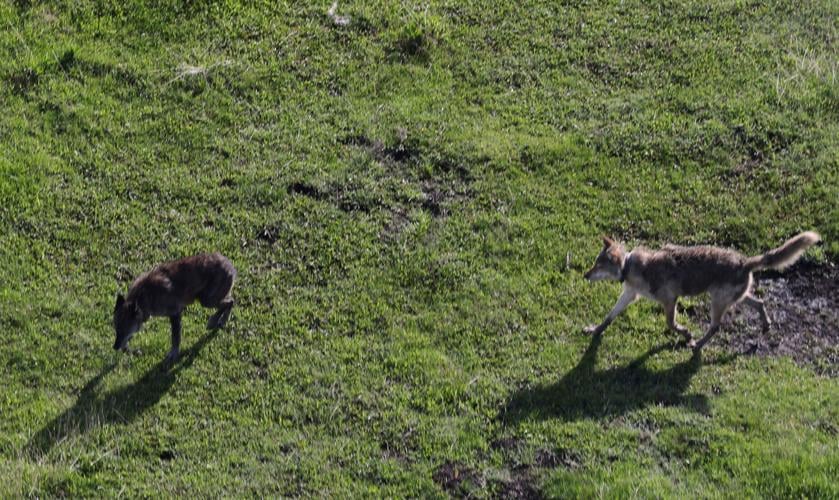
Two wolves trot through a grass field. Junction Butte Pack wolf 907F (right) trots through a field in this aerial photo from 2023. Image courtesy of Yellowstone Wolf Project.
Valuing animals as individuals is essential because each animal has intrinsic worth — including unique experiences and emotions— and a vital role within their ecosystem. Individual-level valuation recognizes the importance of compassion and ethical treatment of animals, rather than viewing them merely as parts of a species group. Without this lens, we wouldn’t be able to fully appreciate the extraordinary achievements of a wolf like 907F or a grizzly like 399.
However, because state and federal wildlife agencies often apply the North American Model of Wildlife Conservation (NAM), they often disregard the welfare of individual animals, particularly for species deemed predators or nuisances, which can lead to policies allowing their removal or even inhumane treatment.
The NAM’s focus on maintaining population levels of game species for the benefit of hunters and anglers means individual animals, especially non-game species or animals seen as “nuisance” or “predatory,” are often undervalued in management decisions.
By focusing narrowly on population numbers and hunting opportunities instead of valuing animals as individuals more broadly, management decisions of state wildlife agencies often overlook the complex roles and inherent value of a wolf when say, they authorize a kill order. And often, if individual animals are considered, plans tend to frame them only in terms of their utility or impact on other species.
As a result, even well-known and beloved individuals like Grizzly 399 are not protected from the impacts of development, human-wildlife conflict, or policies that prioritize hunting over holistic conservation efforts. The current model of thinking also discourages public engagement in conservation that isn’t in line with the way things are currently run. And this “science” ignores the growing body of evidence about the complex emotional lives individual animals lead, as well as the educational value they bring to communities, further limiting the tools available to conserve biodiversity amid habitat fragmentation and increasing human activity.
By shifting away from population-based metrics alone, agencies could adopt policies that support both the welfare of individual animals and the broader ecosystem, aligning more closely with the public’s growing concern for all species, game and nongame alike.
 That’s why we’re calling for a shift in the wildlife management philosophy to one that values animals as individuals. Decisions should be focused on compassion and coexistence, following ecologically sound and ethically responsible policies that reflect public support for biodiversity and animal welfare.
That’s why we’re calling for a shift in the wildlife management philosophy to one that values animals as individuals. Decisions should be focused on compassion and coexistence, following ecologically sound and ethically responsible policies that reflect public support for biodiversity and animal welfare.
Watch Wildlife for All’s Executive Director, Michelle Lute, speak more on this.
